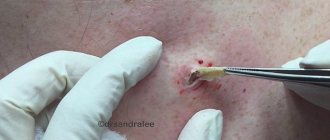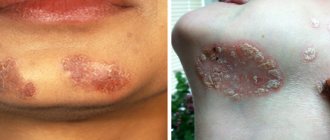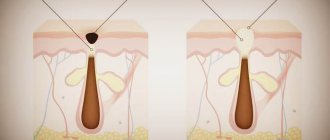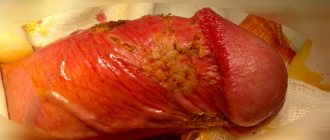Vitamin deficiency, temperature changes, hormonal imbalance and other reasons can lead to areas of dryness and flaking on the face. Yes, of course, prevention, competent care - all this will help in overcoming and preventing the problem. What should you do if the skin on your face is peeling, and you are running out of time to correct the problem? There are effective, and most importantly quick, ways to relieve redness and flaking of the skin on the face.
Photo from website: heaclub.ru
So, emergency help from the well-groomed beauty portal - how to get rid of peeling skin on the face: methods, rules, life hacks.
Peeling facial skin: treatment at home ↑
Why the skin on the face peels is a question that any woman who faces a similar problem asks herself. Dry areas on the surface of the skin not only make it less attractive, but also create the preconditions for the formation of wrinkles - as you know, dehydrated dermis cannot produce enough elastin and collagen, and therefore quickly loses its elasticity.
What to do in this situation? First of all, it is necessary to find out the reason for the dehydration of the upper layer of the epidermis - why your skin suddenly became dry. In winter, the flaky dermis most of all needs nutrition and vitamin complexes. Fat and rich creams, masks that restore water balance, homemade scrubs and peelings are suitable for this. It also wouldn’t hurt to introduce vitamin complexes containing group B substances into your diet – they are the ones responsible for the condition and beauty of our skin. A humidifier will help soften the dermis of the face during the heating season - it is better to place it closer to the bed and turn it on during night sleep.
Both commercial cosmetic products and folk recipes help against skin flaking, or you can use both to achieve a better effect. But first you need to eliminate the cause of excessive dryness - without this, the problem will return again. It often happens that the peeling off of particles is caused by excessive use of the sun and tanning, frequent trips to the pool, which contains water treated with chemicals, windy weather, lack of vitamins, or even an incorrectly selected cleanser.
A cream for flaky facial skin must be chosen wisely and have a nourishing structure - gels and light balms are not suitable because they quickly dry out on the surface, which can lead to increased peeling. Also, take a shower and perform daily hygiene procedures with caution - dehydrated skin does not tolerate aggressive detergents and the use of soap.
And, of course, the most important thing is to get rid of the accumulation of dead cells that the epidermis rejects in order to even out the texture of the skin and make it smooth and fresh. Recipes for scrubs that are very easy to make at home with your own hands will help with this.
Complications
If the course is unfavorable, wounds on the face can leave unpleasant consequences:
- Suppuration. Often this complication is a consequence of improper treatment. A wound, even the smallest one, needs to be regularly treated with antiseptics. Stitches must be placed on deep incisions. If doctors' recommendations are violated, long-term non-healing wounds on the face become infected with bacteria, and the process becomes purulent.
- Scars. The formation of connective tissue at the site of injury is a natural regeneration process. This causes a lot of cosmetic problems on the face. The more extensive the damage and the longer the recovery period, the more noticeable the scars will be. To eliminate them, there are conservative methods (absorbable creams) and surgical ones (plasty).
- Facial nerve injury. This is a more serious consequence, which, unfortunately, is much more difficult to correct. Symptoms depend on the location of the injury and include loss of sensation and movement in certain areas of the face.
Scrub recipes for home use ↑
Are you looking for an affordable way to improve your skin? You don't have to spend a fortune on spas or expensive beauty products to reap the benefits of exfoliation. Here are some simple instructions for creating homemade exfoliating remedies that can be quite effective.
Homemade peelings are convenient because you can get exfoliant particles right in your kitchen. Salt, sugar and oatmeal have granules, making them ideal for removing dead skin layers. But before you make the scrub, check all the ingredients to make sure there are no sharp objects. The main goal of such recipes is to gently cleanse the skin and not scratch it. Overly aggressive exfoliation with a large or sharp exfoliant can lead to skin irritation!
An important note about at-home exfoliation: While scrubbing can be a great addition to your basic self-care routine, there are also times when you shouldn't use it. For example, if you have an allergic or bacterial skin rash or other skin condition. In addition, you should not exfoliate skin that has fresh abrasions, cuts, or recent tanning.
Oatmeal scrub against flaking on the face ↑
Sometimes a simple recipe is the best. Oatmeal is a valuable source of B vitamins, and therefore it not only gently cleanses the top layer of skin, making the face smooth and soft, but also revives aging skin deprived of nutrients.
Recipe:
- 2 teaspoons ground oatmeal;
- 1 teaspoon of soda.
Mix ground oats with baking soda. Mix, adding a little water - just a couple of drops - to form a thick paste. Apply the resulting mixture to your face, gently rubbing in circular motions. Rinse the skin with cool water and blot with a clean towel.
Sweet face scrub ↑
Do you want to not only get rid of flaking and make your face radiant and soft, but also pamper yourself? Try this recipe in true spa style!
Recipe:
- 2 tablespoons finely chopped oatmeal;
- 2 tablespoons granulated sugar;
- 2 tablespoons brown sugar;
- 1/2 cup vegetable or almond oil (almond is better);
- 1 teaspoon nutmeg.
Mix all ingredients. Mix well. Apply to damp face, lightly rubbing the scrub into the skin. Rinse your face with warm and then cool water, then dry your skin with a clean towel and apply your usual moisturizer.
Remember - when you plan to exfoliate your skin, you must take extra care to avoid scratching or irritating it. Sudden movements and deep rubbing of particles into the epidermis are unacceptable!
Body and face scrub ↑
If you have peeling skin not only on your face, but also on your body, then it won’t hurt to tidy it up by making a fragrant scrub based on ordinary sugar. Fine granulated granulated sugar is perfect for gentle yet effective exfoliation!
Recipe:
- 1 cup granulated sugar;
- 1/2 cup butter (almond oil is best);
- 10 drops of any essential oil.
Mix sugar and butter until completely combined. Add 10-15 drops of essential oil for fragrance if desired. Orange and lemon oils are perfect - these oils perfectly nourish the skin and restore its softness and beauty.
Apply the mixture to damp skin with your hands, a washcloth, sponge or hard glove, gently rubbing in a circular motion. Rinse well. After use, apply milk or light body balm to damp skin.
Salt body scrub ↑
Like the sugar scrub above, this salt scrub is suitable for the body but should not be used on the face. Salt is an excellent assistant in the fight for elastic and smooth skin without flaking, but for facial skin this method is quite aggressive, and therefore sugar granules are usually used instead of salt.
Recipe:
- 1/2 cup (sea salt is best);
- 1/2 cup vegetable oil (preferably almonds);
- Fragrance if necessary.
Mix salt and vegetable oil until completely combined. Add 10-15 drops of essential oil if you want to add aroma to the scrub (you can use kritsa oil, cocoa). Apply the mixture to damp skin with your hands, a washcloth, sponge or glove, gently rubbing in a circular motion. Then rinse well.
Soda scrub for face and body ↑
Baking soda is a mild abrasive that can be used for exfoliation. It's also a very affordable ingredient, perfect for budget beauty lovers.
Recipe:
- Baking soda;
- Purified water;
- Essential oil if desired.
Mix a small amount (1-3 teaspoons for face and 1-3 tablespoons for body) with enough water so that the mixture can be easily applied to the skin. Add a drop or two of essential oil if desired. Apply the scrub to the skin with a glove or sponge, gently massaging in circular motions. Rinse off the mixture with warm water.
First aid and treatment of abrasions
As a rule, an abrasion appears on any part of the body as a result of a fall or impact with a blunt object. In this case, bruising of soft tissues and damage to the skin occurs, as a result of which swelling and redness quickly appear, gradually turning into a hematoma, and if the vessels are superficial, capillary bleeding may begin.
Since an abrasion is accompanied by damage to the skin, it must be treated, not only to cleanse it of contaminants, but also to prevent the penetration of various harmful bacteria and viruses into the body.
If you receive an abrasion, it should be washed with clean running water and soap, preferably ordinary household or children's soap without additives. Soap allows you to not only effectively remove various contaminants from the damaged surface, but also eliminate many types of dangerous bacteria. But such processing will not be enough.
It is important to disinfect the wound using special antiseptic solutions such as hydrogen peroxide, Miramistin, Chlorhexidine, a weak solution of potassium permanganate, Furacilin diluted in water.
Some solutions can simply be poured onto the surface of the damage and wait a little for the composition to penetrate the damaged tissue and eliminate pathogenic microorganisms. But you can’t do the same if, of all the drugs on hand, only hydrogen peroxide.
To treat with the solution, you should take a gauze swab, moisten it in the solution and use it to carefully apply the substance with blotting movements to the surface of the abrasion and the skin around it.
After disinfection, one of the means to accelerate healing can be applied to the wound in the form of a powder, gel, cream or ointment, over which a bandage of gauze secured with a bandage must be applied.
Mask for flaky facial skin ↑
This recipe is suitable for softening the surface of the face, making the skin smooth and even, and reducing the appearance of flaking and dryness. It will require the simplest ingredients, and the mask itself is performed in two stages.
Recipe:
- Dry natural cocoa powder – 2 teaspoons;
- Cream – 2 teaspoons;
- Cocoa butter – half a teaspoon;
- Bee honey – 1 teaspoon;
- Ground coffee - half a teaspoon.
How to make a mask against peeling skin ↑
First, mix honey and ground coffee - it is better to choose liquid fresh honey, and fine coffee, for espresso (you can use already drunk). Wash your face with warm water and pre-steam your face for better results. Gently rub the mixture onto the skin, massaging it slightly in a circular motion. Leave on for 15 minutes, then rinse with water. After this, stir dry cocoa powder with warm cream and cocoa butter. Spread the paste on the surface of the skin and leave for 15-20 minutes. When the time is up, wash your face and apply moisturizer to your face.
Rules of care
p, blockquote 29,0,0,0,0 —>
To speed up healing, it is not enough to use only ointments prescribed by a doctor. It is very important at any stage of restoration of damaged tissue to properly care for the skin. This will avoid aggressive, irritating factors and will promote rapid cell regeneration.
p, blockquote 30,0,0,0,0 —>
- Washing the affected area. If no dirt gets into the wound, it will be enough to direct a stream of running clean water into it. If severe contamination occurs, you will have to use antiseptic solutions. If pharmaceutical products are not at hand, use regular soap.
- Next, a bandage is applied to protect against new contamination and stop bleeding. For this, a sterile bandage and cotton wool are used.
- Do not stick the patch on, because when removed it will tear the edges of the wound even more.
- You can leave the area open to help it heal faster, but this increases the risk of infection.
- If healing is successful, the bactericidal patch can only be used after 3-4 days. It will need to be constantly changed.
- Hide injured skin from temperature changes, frost and ultraviolet radiation.
- Until it is completely healed, do not visit solariums, baths, or swimming pools.
- If the wound remains unhealed within 2-3 weeks, infection has most likely occurred. You will have to see a doctor and undergo a course of antibiotic treatment.
- Food should be enriched with vitamins and proteins. Eat fresh vegetables and fruits, dairy products, nuts, and herbs daily.
- Keep the surface perfectly clean.
- You cannot treat wounds on the face on your own, only with folk remedies. Remember: your appearance will depend on this. You should consult your doctor about using even aloe juice.
If damaged skin is provided with proper care, most likely everything will work out without consequences for beauty and health. This requires patience so as not to give up and despair every time you look in the mirror.
p, blockquote 31,0,0,0,0 —>
Bandages, dressings, plasters and ointments will soon run out if done correctly. Otherwise, you will have to face complications.
p, blockquote 32,0,0,0,0 —>
Wow! In America, Indian tribes used soldier ants, which had well-developed powerful jaws, to heal wounds. They launched insects onto the damaged area of the skin, and with their jaws they tightened the edges of the wound, preventing them from moving apart.
p, blockquote 34,0,0,0,0 —>
Video: mask for dry skin ↑
Now you know how to exfoliate your facial skin at home to get rid of dryness and even out the texture of the epidermis.
It is recommended to use scrubs no more than twice a week - this is the optimal amount to get rid of the existing problem and not harm the health of the skin. Do you have a recipe for a miracle cure?! Share your beauty secrets with us in the comments?!
Be healthy ! With warmth and care, Ravila.
Similar posts
Facial cleansing at home - real, effective, cheapSpices for facial beauty: the best mask recipesHealing plants for beautiful facial skin at homeEffective peelings and masks for dull facial skinMask recipes for velvety facial skinHow to make skin elastic: procedures at home
Cosmetologists' opinions
Many cosmetologists and supporters of proper facial skin care have come to the consensus that applying a greasy cream at night spoils the epidermis and contributes to its rapid aging. We don’t let our skin rest day or night, and then we wonder where the swelling and wrinkles come from?
Harm from using the cream at night:
- A greasy or nourishing cream tightly “clogs” the pores, preventing the skin from renewing itself and removing harmful substances.
- The cream breaks down the natural immunity, preventing the skin from cleansing and restoring itself.
- Most night creams have chemical additives that accumulate in cells, which leads to aging of the skin. Night creams should be applied 3 hours before bedtime , then blotted with a napkin, and before going to bed, thoroughly cleanse the face of any unnatural buildup.
Causes, preventive measures
Even with healthy skin, cold wind makes the face chapped. This happens not only during a winter ski holiday, but on the way to work, to the store, or while walking.
There is little moisture in the frosty air. Intense dry cold wind dries out. The skin's loss of moisture and natural protection makes the face chapped. Ultraviolet radiation from the sun, even in winter or through clouds on a cloudy autumn day, aggravates skin damage.
Protect your face from chapping with glasses, a headscarf or scarf, a wide-brimmed hat, and applying sunscreen to exposed areas.
Chapping warns egg yolk:
- Apply a small amount generously.
- When it dries, rinse with warm water.
Zinc ointment
Is it possible to use zinc ointment?
Zinc ointment is capable of:
- protect from sun rays and burns;
- prevent irritation;
- adsorb harmful substances;
- act as an anti-inflammatory and antiseptic;
- maintain the elasticity of the skin, make small wrinkles invisible; soften, smooth out the dermis.
Consistent use of this product will help to quickly cure acne and acne marks on the face.
Zinc ointment has no side effects at all, so pregnant and lactating women can use it without fear. Even when caring for newborns, many pediatricians prescribe this drug.
Apply zinc ointment to the face and décolleté area in a thin layer 4-5 times a day. The course of treatment is 14 days.









